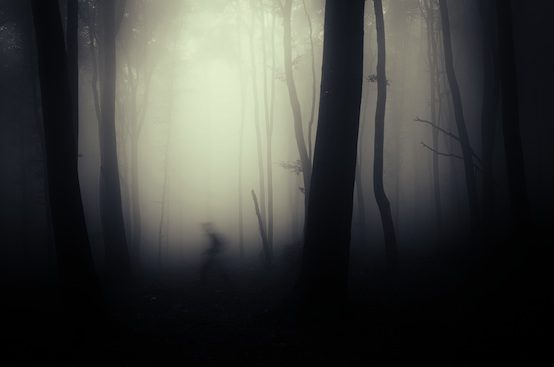Slenderman and the “Mythos” of Modernism

On May 31, a bicyclist found a young girl, stabbed 19 times with a five inch blade, after she crawled out of the Wisconsin woods and dragged herself toward the nearest road.
The perpetrators Morgan Geyser and Anissa Weier, both 12 and classmates of the victim, are being charged as adults with attempted murder. The stabbing was an attempt to pay tribute to Slenderman, a faceless, betentacled, and besuited character from Internet lore. The two girls were caught along the road after they had committed the crime, apparently walking to an imaginary rendezvous point with Slenderman.
They first discovered Slenderman on the Creepypasta Wiki, which is where most of the current fan fiction resides. They reportedly planned the attack for months, finally luring the victim into the woods with a game of hide-and-seek.
The Slenderman myth is one of the first pieces of popular lore truly borne of the Internet, beginning online and accruing momentum and backstory as people photoshopped and blogged Slenderman into existence. The rapid spread of his legend surprised even Eric Knudsen, Slenderman’s creator. He said in an interview that he didn’t expect it to move beyond the Somethingawful forum where he posted the first Slenderman image:
It was amazing to see people create their own little part of Slender Man in order to perpetuate his existance [sic]. … I found it interesting to watch as sort of an accelerated version of an urban legend.
When he created Slenderman, he said that he wanted something “whose motivations can barely be comprehended,” and that caused “general unease and terror in a general population.” He here pinpoints the power of Slenderman: the omnipotence of the unknown. The Internet has, after all, given us the ability to know every imaginable aspect of our world; but not to belong to it.
Vice chalks the violence up to poorly-managed hormones and small-town boredom. An Mytheos Holt at R Street asks whether their violence could have been prevented by addressing mental illness openly. Farhad Manjoo at the New York Times makes Slenderman’s faceless horror emblematic of the “selfie” age—an attempt to use fear to push against compulsive, narcissistic self-documentation.
Collin Barnes, Assistant Professor of Psychology at Hillsdale College, mentioned in an e-mail that the need to find meaning and community, to craft an identity, could have driven the crime, “Killing in the name of Slenderman and investing oneself in religious rituals are not entirely different and may reflect latent fears we have about being utterly alone in the universe.”
In the mythos, Slenderman’s victims are always alone, and radically estranged from help or support. There is no intelligible pattern or motive to the victimization. In contrast to the bogeymen of “organic” folklore, he has no distinct vendetta against transgressors of social or moral norms.
The two girls were not driven to violence by their encounter with Slenderman. He was emblematic of faceless, nameless dread: of complete alienation. As Kathleen Hale pointed out at Vice, girls of their age are experiencing radical emotional isolation, and possible mental health issues and public school social dynamics only exacerbate the problem. In a way, the killing was a gesture of solidarity, an attempt to connect with someone or something when faced with being “utterly alone.” Slenderman is the demon of a suburban age.
Comments